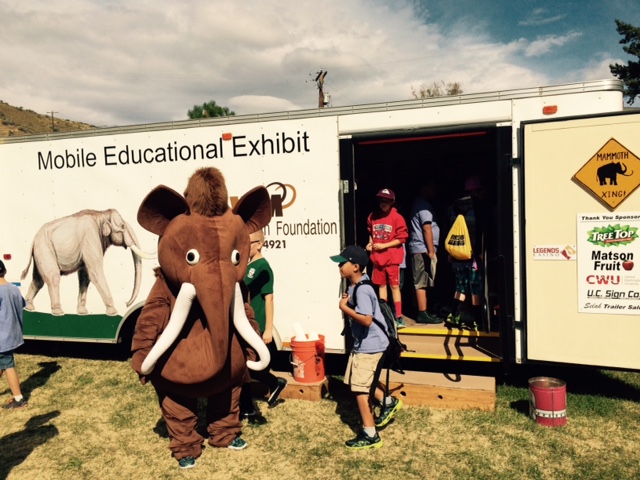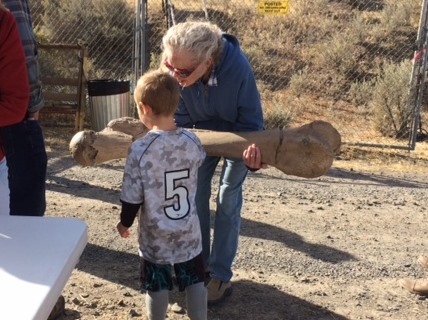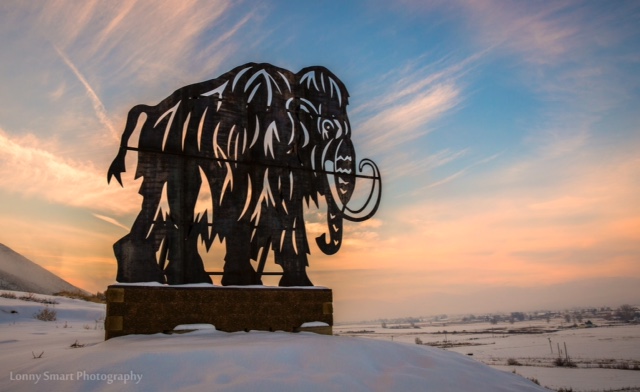By Bronwyn Mayo
In 2005, while constructing a road on a hillside overlooking the Wenas Valley, north of Selah, in Central Washington State, the left front leg (Humerus) bone of a mammoth was uncovered. The Wenas Mammoth find is on private property owned by Douglas and Bronwyn Mayo. Finds of isolated mammoth elements are common on the Columbia Plateau; however, these remains have been found in the Missoula Flood deposits. The Wenas Mammoth is unusual because it is well preserved, at an elevation 300’ above the Missoula Flood deposits.
During the summers from 2005 – 2010, Central WA University (CWU) conducted field schools for scientific investigation of the mammoth bones, called the Wenas Creek Mammoth Project. The interdisciplinary project used methods from paleontology, archaeology, and geology. The project’s goal was the careful scientific recovery of bones and associated artifacts, while placing the finds into an appropriate context of physical geography. Each year’s project included the field school, public tours, presentations, and volunteer opportunities, averaging over 2,000 visitors each four-week period. During that time, a Bison antiquus and a man-made flake were also discovered, and the finds were found to date back 17,000 years.

In 2012, with the driving force of the land owners, a group of local educators and supporters began the process of forming the Wenas Mammoth Foundation (WMF), a non-profit 501c3 corporation. The mission of the WMF is to promote, preserve and utilize the Central WA Dig Site and its natural science and history, and to inspire the pursuit of educational opportunities throughout WA State. The WMF was aware that there is a need to improve mathematics, science, and critical thinking skills for K-16 students, and prepare them for careers. The 2016-17 Science Assessment Scores for WA State (OSPI) for the 8th grade Science Exam demonstrated only 65% proficiency, and in South Central Washington region, those scores were at 47% and below, depending on the district.
Over the years the WMF has created fun and interactive learning activities for students to explore and be inspired about earth science by utilizing our local natural environments and history. The WMF’s goal includes offering exciting avenues for educators, professionals, scientists, and students. This is delivered through innovative hands-on curriculum that meets the Next Generation Science Standards (Disciplinary Core Ideas and Crosscutting Concepts). The WMF’s Educational Program also supports STEAM (Science, Technology, Engineering, Art, and Math), and CTE (Career and Technical Education).
Educational Program includes:
WMF’s Mobile Educational Exhibit and Program: This exhibit and program visits schools and community events throughout the year. The Mobile Educational Exhibit is a small museum that brings Ice Age history to the schools. The exhibit has displays that support the variety of lesson topics that are offered in a classroom or assembly setting. The lesson topics include:
- What are mammoths and mastodons?
- Identifying Mammoth Skeletons and Other Ice Age Specimens
- Habitat and Biological Evolution of the Proboscidean Family
- The Teeth and Tusks Can Tell A Story (Grazers and Browsers)
- Analyzing the Soil for Clues (Evaluating 17,000-Year-Old Soil Samples)
- The Evolution of the Wenas Bison Antiquus
- The History of the Wenas Creek Mammoth Project
- Mysteries of Wenas Mammoth Mountain
- Volcanoes of Central WA State

Hands-on Activities: The WMF is developing fun hands-on activities to engage students’ curiosity. This may include exposing bones using brushes, and then identifying what was discovered. It may also be sifting for artifacts in a dig box or exposing large full-size mammoth bones (casts) in a large dig area. Whatever the activity, all ages want to join in.
2018 Paleontology Youth Summer Day Camp: The WMF will be introducing 4-12th grade students to the methods of paleontology and archaeology at their first youth summer day camp. This year’s focus will be on the methods of setting up the digging unit, and why. Students will have dig site hands-on activities, as well as classroom lessons and activities.
STEAM and CTE Projects: Whatever the project may be, STEAM and CTE students to have the opportunity to take the skills they are learning in the classroom out into the field.

WMF Signage: In May 2012, the mountain on which the Wenas Mammoth was discovered was officially named Wenas Mammoth Mountain by the WA State Board on Geographic Names and the U. S. Board on Geographic Names. In celebration of this, the YV-Tech Welding Program students (CTE) fabricated a sign “Wenas Mammoth Mountain”, that sits at the foot of the hillside.
Mobile Educational Exhibit: When the WMF began planning the mobile exhibit the need for display cabinets was critical. Wood Shop class (CTE) students from West Valley High School stepped up to the task and constructed display cabinets on both sides of the trailer.
Silhouette Projects (CTE): In 2015, the YV-Tech Skill Center Construction Program and the Perry Technical Institute’s Welding Program answered the question “How big was the Mammoth?” by fabricating and erecting a life-size mammoth. The construction students prepared the foundation and the welding students fabricated and erected the mammoth. Several local photographers have taken many breathtaking photos of the silhouette. Perry Technical Institute’s Welding program is currently fabricating and will be erecting the Wenas Bison antiquus silhouette soon.
 |
Mural Projects (STEAM): In 2017 and 2018, art class students from La Salle High School painted murals on 40’ cargo boxes. During the school year students, under the guidance of their art instructor Mrs. Jones-Campbell, had to research, plan and practice their artwork. The goal is to visualize what the Wenas Valley looked like 17,000 years ago.
It Takes A Community: The discovery of the Wenas Mammoth has changed how folks look at the Wenas Valley. Many people ask, “How did you find the mammoth?” We simply reply, “We didn’t find the mammoth, it found us… and boy has that changed our lives!” However, it takes more than finding a mammoth and having a dream to make it into an educational opportunity. It also takes the dedication of people within our community and organizations to be successful. You can keep up on our story, and view photos and videos at www.WenasMammoth.com or on www.Facebook.com/WenasMammoth.









